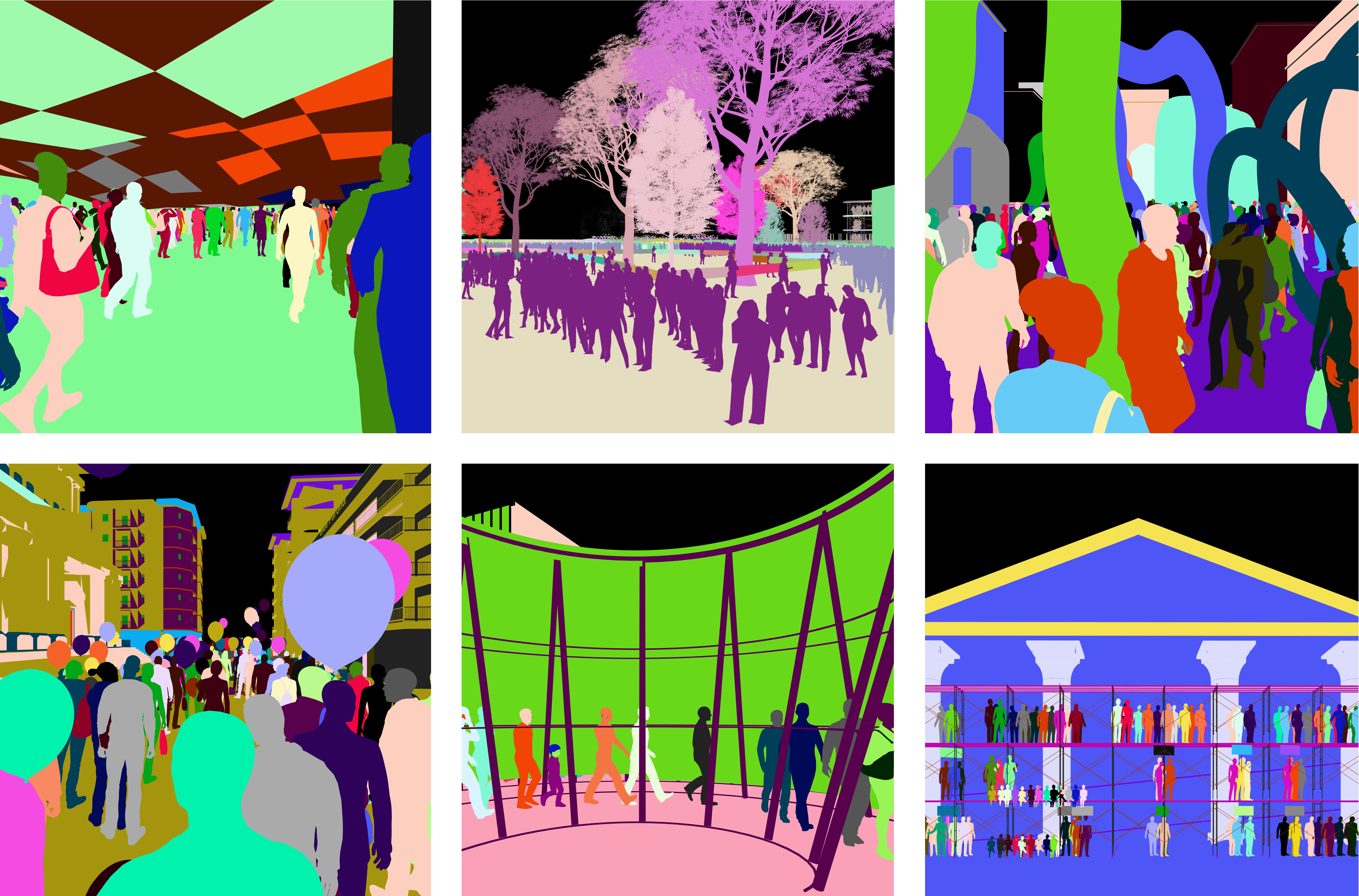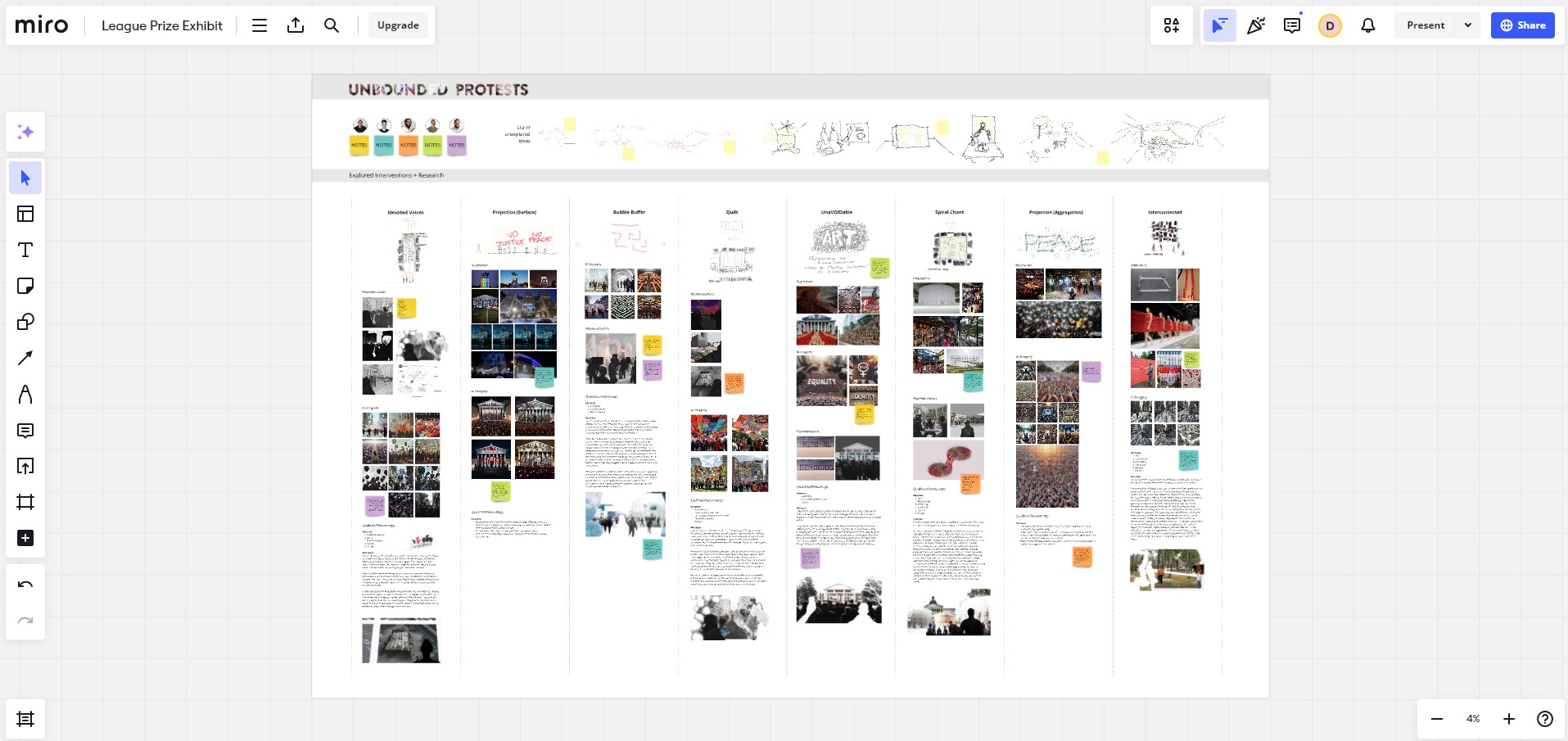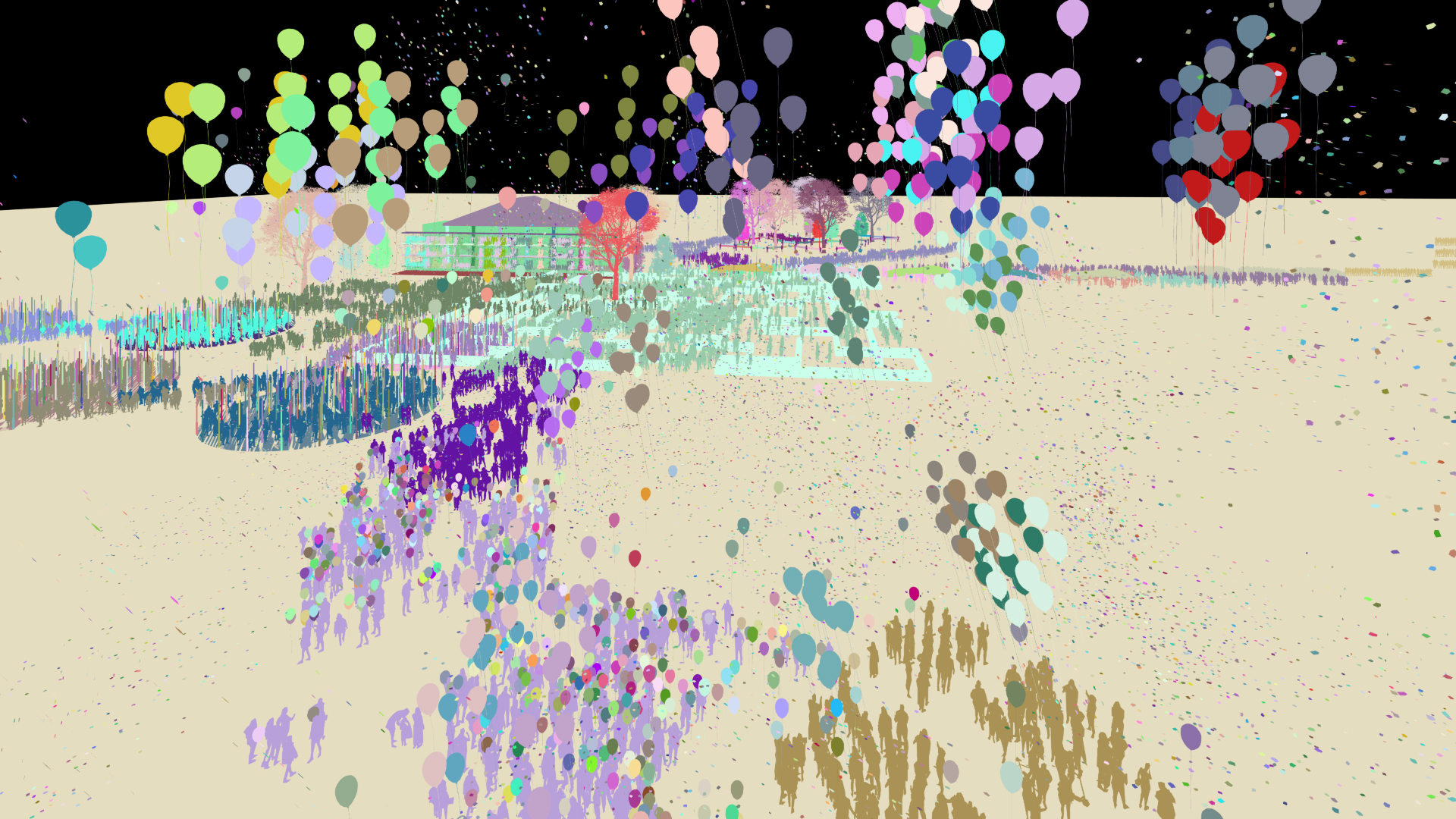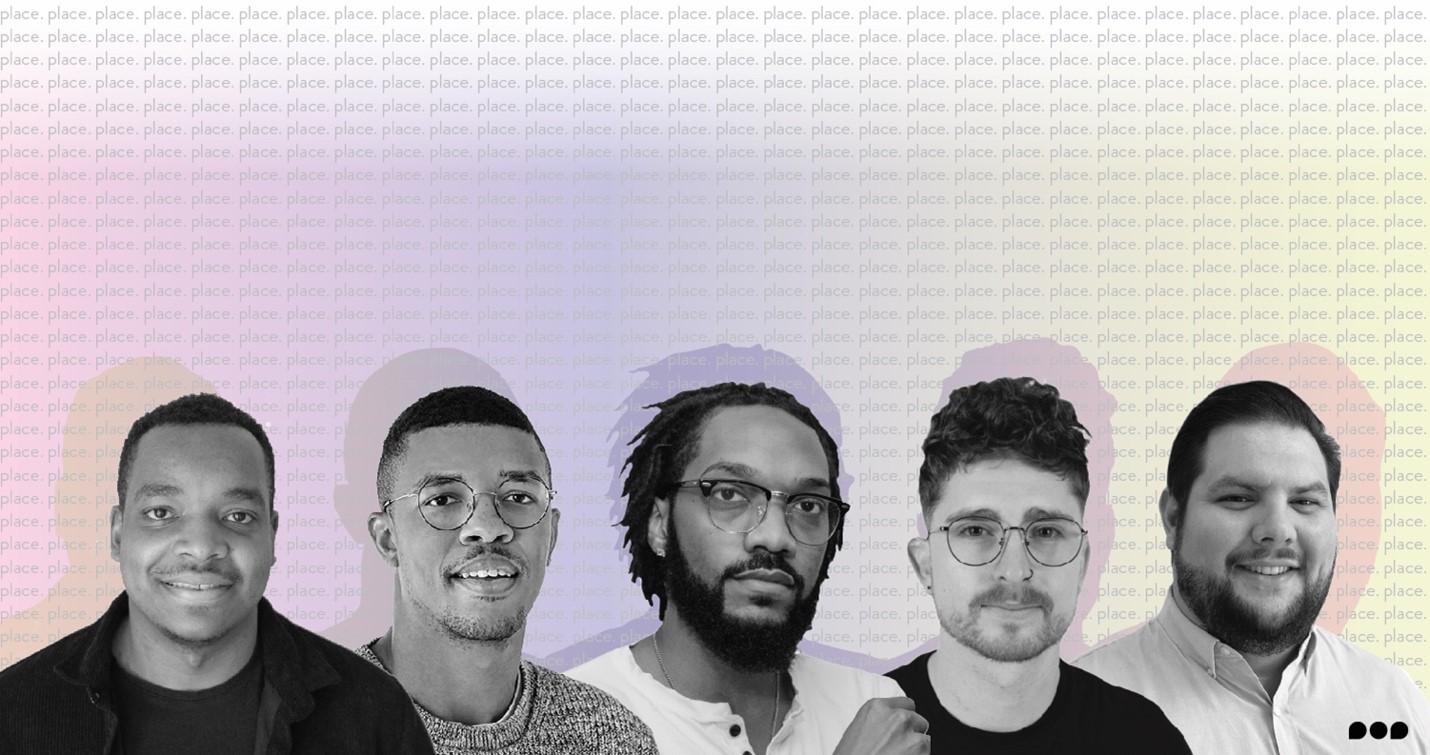Building a Collective Voice
The five members of design collective Partners of Place reflect on their evolving working methods and digital projects that meet the moment.
Partners of Place (PoP) is a 2024 League Prize winner.
Partners of Place was established in 2023 by Rayshad Dorsey, Joseph James, Diego Zubizarreta Otero, Julian Owens, and Michael Urueta. The collective creates digital and speculative projects focused on social and environmental equity. Integrating techniques of data analysis, historical mapping, and storytelling with architectural visualization, their work imagines a more inclusive future. PoP’s League Prize installation examines the spatiality of protest, proposing six materially diverse interventions designed to create opportunities for dialogue.
The League’s Zoe Fruchter spoke with all five partners from the places around the country that they call home, including Greenville, South Carolina; Austin, Texas; and Brooklyn, New York.
*
Zoe Fruchter: In your installation Unbounded Protests, you propose a series of spatial interventions that aim to support social advocacy while promoting safety and access in a protest environment. How did you conceive your installation concept in response to the theme “Dirty?”
Diego Zubizarreta Otero: We had considerable exploration looking for the installation topic. At first we were looking broadly at the issue of physical barriers in society. This larger concept wove through topics that are both important to us and very present in terms of infrastructural systems creating divisions or boundaries between groups. We landed at the concept of protest because it reflected topics around social activism, both in terms of groups of people with very different interests and agendas, and something very universal.
Rayshad Dorsey: We were looking at the history of protest inspired by the civil rights movement and, through the form of architecture, questioning the spatiality of protests. We also looked at how protesters are perceived and how that relates to notions of dirtiness. In the Civil Rights protests, the aggressors would use hoses to spray people. It’s a very oppressive and provocative tactic. We thought, what can we do to even the playing fields of protest as opposed to [the dynamic of] agitators and enforcers? How can we spatialize that?
Joseph James: In a lot of our work, we look at dirtiness as a social imposition. And so part of that, within architecture, is the idea of hostile architecture as it relates to counter-protest. When we were considering the idea of borders, one of the things we were looking at was the materialities of fences, from a metal post to a barricade to a line of police or protesters. And so we wanted to play with the absurdity of materiality as protest. In the installation video, there is an evolution from stitched fabric to the malleability of rubber and different forms of plastic architecture to a more permanent steel structure. But what really defines the space is the people and how they interact with it.
Fruchter: Your collective has five members; you met as students and now each have jobs in academia and corporate practice. How did your collaborative methods and dynamics inform the evolution of the installation concept?
James: We were throwing ideas out there, as we always do. And we were looking at this idea of a beautiful hedge in a really nice neighborhood. It’s implied that the hedge is a border because there’s wealth ascribed to it, but at the same time, there’s this understanding of a gated community—there are implied boundaries and very explicit boundaries, and the social relationship of people is an extension of those implicit boundaries. We now live in a world where the most secure place doesn’t actually need to express a fence because of surveillance. That led us to probably 20 different versions of what these boundaries could be.
Dorsey: We were using AI-generated imagery to explore ideas. Joseph would put something on our Miro board that reflected a response to materiality and boundaries, and then I would take what he did and type a response into AI to see what that would create. We were having a conversation virtually, without speaking to each other. It became our drawing table, which is really cool to see and work with.
James: It was like this game of telephone through AI generation. Where there were disconnects in language, to call AI an extension of language, there were opportunities for new exploration, in the same way we iterate through models and don’t necessarily always know exactly what we’re going to get. And then we could start to be intentional about what we wanted to generate. The process allowed us to not be overly focused on trying to prescribe an outcome but rather be open to and respond to outcomes.
Fruchter: As AI gains prevalence in the field, we confront the question of whether these applications can catalyze the creation of new images and representations, or replicate and even exacerbate existing patterns. Could you speak to your curation of images and texts in this installation, both in terms of what you’re feeding into AI and other choices such as the poems featured in the video?
Michael Urueta: I think that the way we utilize AI is essentially just another tool. And just like with any technology, you don’t want that to be the driver of the design. The poems, narrative, sketches, and storytelling that we did really drove the visuals that were generated. But I think it’s also interesting that in many of our projects, including this one, sometimes there’s just no representation within existing typologies or examples of what we were trying to convey. And so that’s when AI becomes another tool for exploration and creativity.
Dorsey: We learned a lot just from the use of our toolkit: image-based AI engines, Rhino, Miro, digital sketching, Zoom conversations—we take these typical tools we use as designers for granted. When we started having to use them because we were in different places, you could find the limitations [of each medium]. There are certain words we couldn’t even use in AI engines because the platforms wouldn’t accept them. Or, with Rhino alone, you can’t go too far in terms of representing an immersive experience. We never wanted to use these things in silos. A lot of our process is generating an image, taking that image, making it a model, taking that model into AI, and seeing what that result becomes.
James: We decontextualized a lot of the surroundings around the protest and made the protest itself drive what was happening. Part of that decontextualization was so there wasn’t a central idea of what we were conducting a protest about. We start the exhibition video with poetry and all of the poetry is coming from white Americans or Europeans, and then the sounds that you’re hearing in the background are coming from Black Lives Matter protests, and then the first intervention is this quilt blanket that evokes the AIDS quilt—we’re not necessarily favoring one protest movement over another.
Fruchter: A central theme of your practice is translating between social issues and spatial ideas. Who would you like to reach with your work?
Urueta: Collectively, we have an ethos of expressing under-told stories. I don’t think we ask ourselves “who?” but more like, “how?” How can we make this the most accessible? And so that’s why many of the projects we’ve designed have been documented in a way that allows them to live on not only physically, but also digitally. By sharing them through our website or on social media, everybody can access them.
Julian Owens: I think the hope is that anybody can listen to the messages that we’re portraying. We had a conversation early on in the development of the installation about how, with some of our previous projects, the subject matter might make people a little uncomfortable. And I’m not gonna lie, we kind of enjoy stirring up uncomfortable conversations. So the hope is as we’re putting on this exhibit, it’s not just the protesters that are seeing it, but also people that don’t necessarily understand why people go out of their way to protest in the built environment.
Zubizarreta Otero: In a way, architecture has historically been fairly insular and focused on very specific issues, and in the past the field has been associated with a certain elitism, being reserved to social groups of high status or influence. As architects, designers, and urbanists, we’re all working to make design accessible by taking on universal, relatable topics and applying our training, our education, and our critical analysis of space to break down ideas and concepts and promote dialogue.
Dorsey: All of our projects boil down to people and our perception of how we become better people. When you look at Unbounded Protests and our typologies, they’re all about how you mediate that middle ground between the protester, the agitator, and the bystander. How can they all become a part of one conversation where progress can happen?
Zubizarreta Otero: And we don’t really know, right? I think it’s really important to emphasize that the initial goal isn’t always proposing a solution, or even that there is a single solution.What we hope to come out of the work is engagement and different perspectives, and only when we’ve gained a holistic understanding of the communities and stakeholders in a project, do we feel empowered to propose and design spatial and architectural interventions around a place, space, or community.
Fruchter: Partners of Place was founded in 2023. How has this opportunity impacted your practice? What’s next?
Urueta: In a lot of ways, the League Prize generated much of our workflow and design process, which has been immensely rewarding and helpful as we continue to go forward as a collective. We had all been working collaboratively together in somewhat impromptu ways but not as a defined collective. The idea was that we were going to enter the competition to build our portfolio and to think critically about different ideas. And it just so happened that we won, and we’ve propelled from there.
Dorsey: I will be quite honest, we still don’t know what direction we’re heading, which is exciting. The League Prize emboldened us to know that we’re doing the right thing. I think a lot of our portfolio and the installation were very loose, and if we could start to get some materiality into these projects, that would be a path forward.
James: While we as a collective are new, so much of our work is grounded in rich histories that have lived much longer than any of us but are under-embraced and under-told. Part of what architecture has the capacity to do is envision things in new ways. A lot of times we are so stuck to precedent as the driver of everything, and there is counter-precedent that hasn’t been explored but could be if it were empowered and given a budget, time, and the freedom of flexibility. A lot of privilege exists within the ability to sit still and imagine. It’s important to imagine a world for the people that don’t necessarily get the time and the space to think about what they would love to see in the world, and reflect it back. We hope to continue to do that work and empower others to do work like that.
Interview edited for length and clarity.






